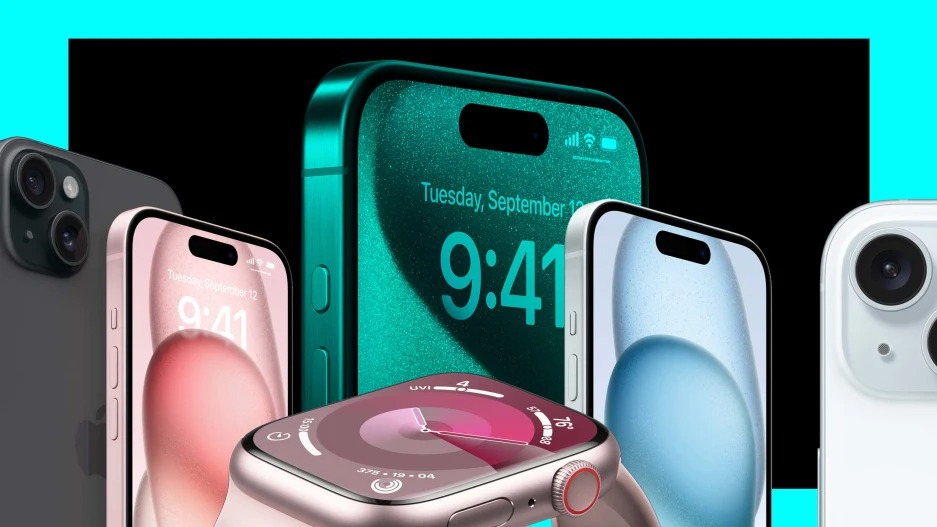- | 8:00 am
We judge new Apple products the wrong way. The iPhone 15 proves it
Being bowled over by technological breakthroughs is fun. But it’s quality-of-life improvements that matter most—regardless of how they came about.

Apologies for beginning this newsletter with a painfully obvious statement, but I hope you’ll bear with me: How impressed you were by this week’s iPhone/Apple Watch event at Apple Park depended on your expectations going in.
If, like some people, you’d be satisfied only by transformative surprises that hadn’t leaked ahead of time, you were sorely disappointed. By contrast, if you’re the type of person who craves technical details on matters such as raytracing performance in games, you may have been quite pleased. (Apple, which used to be pretty steadfast in its refusal to dwell on specs for specs’ sake, can get pretty nerdy these days—probably because it designs its own chips and wants you to know how advanced they are.)
But there’s a third way to assess Apple launches. I’ve only come around to it myself lately, so I understand if you haven’t embraced it. All you need to do is stop obsessing over the backstory of each piece of news—whether it’s a dazzling technical feat, a refinement of an existing feature, or something that Apple should have offered years ago. Instead, simply judge it by what I’m going to call the “It just works” factor.
In other words, ask yourself this question: Does it appear that a new feature will make your life better all the time without introducing new complications? If so, that’s good news. And if an event has lots of those features, it’s really good news.
Rating Apple news this way is in sync with the company’s own design goals, which is where “It just works” came from in the first place. (It was a favorite claim of Steve Jobs in his Stevenotes.) It might even make the whole exercise of watching one of the company’s events more enjoyable, which can’t hurt when you’re devoting more than an hour of your life to consuming something that’s ultimately a glitzy commercial.
By the standards of “It just works,” Apple’s latest announcements look solid. A sampling:
- The iPhone 15 Pro and Pro Max have turned in their ringer buttons for a customizable action button that can perform a variety of additional tasks, from turning on the flashlight to recording a voice memo to launching your own shortcut automations.
- Apple is finally retiring its venerable Lightning connector for USB-C, a major step in the never-ending battle to reduce the number of cables in our lives.
- Taking portraits with the iPhone 15 camera no longer requires tapping around in the camera app to switch modes: Using machine learning, the phone can detect people in your shots and enable portrait shooting on its own.
- The iPhone 15 Pro Max offers a new 5x optical zoom that makes going all in on iPhone photography more of an option even for serious shutterbugs.
- The Apple Watch Series 9’s potent new chip lets it handle Siri requests without offloading them to your iPhone, letting people such as runners get more out of the watch even when their phone isn’t on them.
- The Apple Watch also lets you make a double tap air gesture—similar to the one used by the Apple Vision Pro—to perform tasks such as answering a call, so you can interact with your watch even when you don’t have two hands free.
I should pause to mention that new capabilities can be worthwhile even if you won’t necessarily call on them every day. For example, the iPhone 15 Pro models are getting the ability to capture spatial (3D) video, a tie-in with the not-yet-available Apple Vision Pro. I’m hoping that 3D still photos are also an option, and that the stuff you shoot will work with other devices that support 3D, such as existing VR headsets. If so, I’m intrigued, even if I’d only get occasional use out of the feature.
But the new iPhone feature I’m most smitten with—the action button—is something I might use countless times a day. And as far as I can tell, Apple could have theoretically introduced it on the first iPhone back in 2007. It’s no shocker that we’ve had to wait this long, since the company has always been disciplined about not adding functionality until it’s ready to devote the mental bandwidth necessary to do it right. That’s much easier to tolerate when the payoff is as big as it could be in this case.
As for the long-awaited arrival of USB-C—which sparked what seemed to be genuinely heartfelt applause in the Apple Park audience—Apple deserves no credit at all: It was the EU that forced its hand. Doesn’t matter. It’s still a big deal!
On the far end of the innovation spectrum, the Apple Watch’s double tap—which uses machine learning to detect that you’re intending to perform the gesture rather than just wiggling your fingers in a vaguely similar manner—does look like a technological tour de force. That’s assuming it performs as well in real life as it did during the keynote and later in an up-close demonstration an Apple employee gave me. If it doesn’t, it will just be annoying.
Which brings up my final point. I’m not saying that the “It just works” benchmark involves determining whether something truly does “just work” based on a canned video or quick demo. You can’t. Even for Apple, “It just works” has always been an aspiration rather than a promise it’s consistently fulfilled. Still, it’s a noble goal that many of its competitors don’t take seriously enough. And we should welcome it wherever we see it—regardless of whether any given feature is a “Wow” or merely a “What took so long?”






































